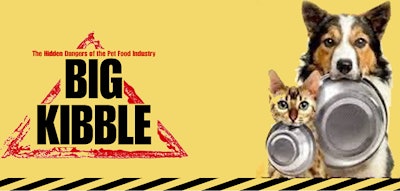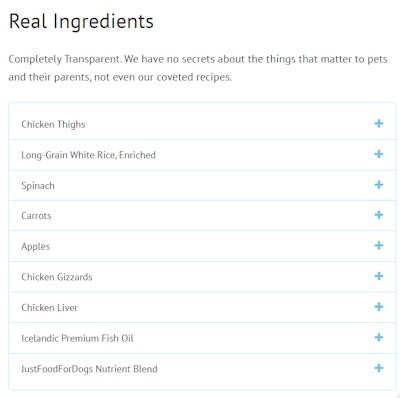
Most of the time, there is a movie based on a book. In this case, I read a book, “Big Kibble: The Hidden Dangers of the Pet Food Industry,” seemingly based on the movie “Pet Fooled” and married to a JustFoodForDogs brochure. While the industry may not have liked “Pet Fooled,” this book was a borderline plagiarized storyline, disguised as a “call to action” for the industry that included a pitch for their own brand of food and vitamin mineral premix.
Book overview: great potential
I think this book, written by Shawn Buckley and Dr. Oscar Chavez (founder and chief medical officer of JustFoodForDogs, respectively), had great potential, starting with the history of dog food from the days of Spratt’s Dog Cakes until today. The book touched on everything from recalls tied to aflatoxin (Diamond Pet Foods), melamine, chicken jerky, pentobarbital contamination (Evanger’s and Smuckers), the canine dilated cardiomyopathy (DCM) debacle, vitamin D recall (Hill’s), the lack of official approval or review of AAFCO feeding trial results by regulatory groups and the extremely low bar for entry into the marketplace.
The authors even covered the well-known and often ignored topic, “Kibble Cash in Vet Schools” (pages 109-117), and lack of nutrition courses in veterinary schools. Lastly, the lack of regulatory enforcement by both the Food and Drug Administration and the states was addressed—which should not be a big surprise to anyone in the industry. How many stores sell CBD-based treats, crickets-based pet foods and other unapproved food products/ingredients for dogs and cats? Unless I missed the headlines, these products have not been pulled from the marketplace.
The big misses in ‘Big Kibble’
Outside of their history lesson and raising awareness around known issues in the industry, the book’s authors failed in a few ways. After Chapter 3, it became a long educational brochure for why you should feed their food. On page 59, they posed the question, “Where, Oh Where, Is Nutrition in All This?” That made me chuckle, because as a board-certified animal nutritionist, I had asked the same question a few pages earlier.
The book briefly covers why carbohydrates and grains are good for dogs (sorry, raw foodies!); however, the authors never present any nutrition data to support the nutrition in their own food. In short, they never really answer their own question, instead focusing solely on ingredients with nothing about nutrition. They also briefly discuss the ongoing work by the Companion Animal Nutrition & Wellness Institute and the University of Georgia, investigating advanced glycation end products from high heat extrusion and their impacts on canine health. Again, this doesn’t answer the question they originally posed on page 59.
Also, the authors missed the opportunity to dive deeper into good food safety programs. Human-grade and USDA-inspected claims alone don’t provide food safety for food products. If that was the case, how does romaine lettuce enter the marketplace and remain there when it is contaminated with E. coli? (Which coincidentally always happens when I want to start my weight-loss diet!)
Sadly, even JustFoodForDogs fell victim to that type of marketing mentality, which ultimately leads to a lack of transparency. Remember their recall for listeria tied to their green beans? A good food safety program (maybe a third-party certification like Safe Quality Food, or SQF) could have helped identify the hazards and critical control points (i.e., cooking) to ensure the product never made it to market or the ingredient never even entered their kitchens.
Sorry, raw pet food feeders!
For all the raw feeders and “dogs need meat only” believers, you will “enjoy” chapter 10, where they say there is no benefit for raw food or high meat products. In a nutshell, according to Buckley and Chavez, you should cook your dog’s food, grains are good and so are carbohydrates!
I wouldn’t get mad about it. If you wrote a 320-page brochure, wouldn’t you make everyone else out to be the bad guy? The only groups not on the hit list were other direct-to-consumer brands like Ollie, The Farmer’s Dog and Pet Plate. Said differently, anything sold in the traditional retail environment is junk! At least according to their opinion.
For the record, The Farmer’s Dog is the leading brand of dog food made with USDA-approved whole foods and fit for human consumption. It’s not JustFoodForDogs, as the book sleeve claims.
Do not throw stones if you live in a glass house!
In a previous blog post, I discussed the need for more transparency in the pet food industry. This book and the authors cover that need as well. However, there is irony in their quest to call out the industry to be more transparent. For instance, the authors complain they are not permitted to place “Premium Icelandic Fish Oil” on their product labels per pet food regulations, which prevents them from telling people about this great ingredient. However, they do not tell you what countries the remainder of their ingredients come from. I wonder why? Isn’t that a lack of transparency?
Also, if you go to their website and look up their Chicken and White Rice Recipe (see screen shot below), you cannot even find a the real ingredient statement. Instead of listing the “added vitamins and minerals” as all other companies do, they list it just one ingredient, “JustFoodForDog’s Nutrient Blend.” Doesn’t that contradict the section entitled, “The Art of Creative Writing AKA Pet Feed Labels 101” (page 127)?
It’s a bit audacious to call out the industry for lack of transparency if you yourself are not transparent in something as simple as an ingredient statement, don’t you think? Especially when the company uses the exact “marketing spin” they advocate against in their book, by how they present ingredients on their website. Based on their site, this formula looks like it contains only nine ingredients. I would call that deceptive.

Recipe on JustFoodForDogs website for Chicken and White Rice product. Date accessed: December 3, 2020
What is really in the food?
If you wanted to know the complete ingredient statement for this JustFoodForDog’s formulation, you would have to visit, online or in person, the pet “feed” store carrying the food to see that the JustFoodForDog’s Nutrient Blend actually contains 14 ingredients, which include: Dicalcium Phosphate Dihydrate, Natural Calcium, Sodium Chloride, Choline Bitartrate, Kelp, Zinc Oxide, Magnesium Bisglycinate Chelate, Vitamin E supplement, Ferrous Bisglycinate Chelate, Copper Bisglycinate Chelate, Vitamin D3 supplement, Calcium d-pantothenate, Riboflavin and Cyanocobalamin.
Even worse, the company still does not disclose the “natural calcium” source. News flash: Transparency goes beyond simply telling the consumer you’re transparent, especially when you’ve duped them into paying for a US$25 brochure! What I find amusing is that they partnered with a retailer that also has transparency issues.
The final big miss
Yes, the pet food industry has flaws. What industry does not? Yet if the bar is set low, that doesn’t mean companies should complain about the low bar and scare you into buying their products. What it does mean is that you should set a new bar and educate.
Many people have heard me say, “I educate. I do not advocate or humiliate.” What does that mean? I teach people to ask the right questions and become their own dog and/or cat’s advocate. I do not advocate for any pet foods (mine included), nor do I humiliate people for what they are feeding. Just because someone cannot afford a homemade, raw or freeze-dried food doesn’t make them a bad pet parent, but they do have the right to be educated to feed the best they can. Therefore, all companies should do their due diligence and be prepared to answer all the questions that retailers and consumers will ask. If you cannot answer the questions, they will find a brand or company that can! For this book, that was a huge miss.
Lastly, if you want to talk lack of transparency in the industry, then you should not be opaque yourself. Tell consumers and retailers why you use the ingredients in your formulas and where all your ingredients come from, rather than using terms like “Premium Icelandic Fish Oil” (which is literally a marketing buzz term). Properly list all your ingredients instead of using the marketing spin that you criticize. Also, you should publish your third-party-verified nutrient analysis and digestibility trial results for each formula you sell.
That, my friends, is transparency.

















